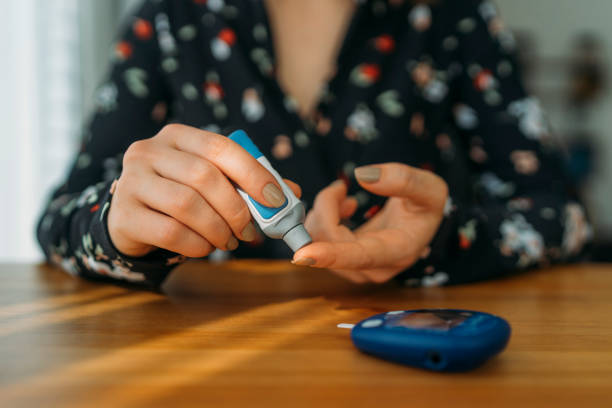Unfortunately, diabetes cannot yet be cured according to the current state of science, but everyday life with blood sugar disease can be made easier with valuable tips. Because regular blood sugar measurement and blood sugar control are part of it you have the blood sugar level under control. Therefore, if you have diabetes, heed the following advice.
What is diabetes?
The so-called diabetes mellitus is usually just called diabetes, blood sugar disease or diabetes in colloquial language. This is a serious and often underestimated disease of the metabolism, in which there is a lack of insulin and, as a result, an increase in blood sugar levels. As a result of diabetes, it is important for those affected to regularly check their blood sugar levels by measuring blood sugar levels.
Blood sugar and its functions in the body

Glucose (dextrose) is our body’s fuel: We absorb it through food and the pancreatic hormone insulin transports it from the bloodstream into our cells, where it is converted into energy. In a healthy person, the pancreas produces exactly the amount of insulin needed to break down the current blood sugar. If the cells are already sufficiently supplied with glucose, the messenger ensures that excess sugar is temporarily stored in the liver and released back into the blood when needed. In this way, the blood sugar level normally stays in a constant range. However, in people with diabetes mellitus, the level of sugar in the blood increases. Also, note our article on identifying types of sugar and reducing sugar.
Differences between type I and II diabetes
While type 1 diabetes is an autoimmune disease, as a result of which the body’s immune system attacks the beta cells in the pancreas and thus prevents insulin production, type 2 diabetes (approx. 85-95% of all those affected) describes insulin resistance. In people with such resistance, the messenger substance can no longer be processed effectively.
Underestimated risk of diabetes
Diabetes mellitus is asymptomatic in the early stages, but if not treated properly, it can damage the heart, kidneys, and other important organs. Risk factors include too little exercise, obesity, and a high-carbohydrate diet. The short-term consequences of high blood glucose levels are constant thirst, fatigue, and often rapid weight loss. The long-term consequences of elevated blood sugar levels are in some cases even irreversible and should therefore be prevented by blood sugar monitoring using blood sugar measurement:
- Damage to the retina is caused by deposits of sugar molecules on the fine capillaries in the eye
- Kidney weakness is caused by the accumulation of sugar molecules in the kidneys
- Circulatory disorders due to hardening of the arteries (can even lead to loss of extremities in severe cases)
Tips for everyday life with diabetes
If you or one of your loved ones has been diagnosed with diabetes mellitus, here are some tips for you on how you can best deal with the disease in stressful everyday life and which are important in addition to regular blood sugar monitoring:
- Stamina is the be-all and end-all when it comes to blood sugar disease. Old habits usually cannot be changed overnight. Therefore, it is important to slowly but permanently establish good habits.
- Excuses don’t count with diabetes. Excuses are only doing yourself a disservice. Accordingly, pursue your goals ambitiously and purposefully.
- Be worth it to yourself. Always remember that your health is at stake. Because it is worth persevering and it provides the necessary motivation.
- relapse allowed. Of course, you can also treat yourself to something and feast to your heart’s content; but this should be kept within limits and be something special for you. no habit.
- Eat healthy snacks in case of diabetes. If you like to snack, try to snack healthily. Nuts, fresh fruit, or, even better, vegetables as a snack between meals fill you up and are healthy.
- Eat slowly. Chewing slowly signals your body that you are already full, even though you haven’t eaten as much as usual. So take your time with your meals and enjoy your food.
- Drink a lot if you have diabetes. The body often sends out the signal to feel hungry, where a large glass of water will do. So always have water on hand and drink it when you think a snack is in order.
- Seek support in case of blood sugar disease. Family or friends can help you achieve your goals. Together in a group, it’s even more fun and you’re all doing something good for each other.
Diabetes therapy: why control is important

While type 2 diabetes can often be reversed with the help of a change in diet and regular exercise, and oral antidiabetics or the administration of insulin are only necessary in some cases, people with type 1 diabetes are on artificial insulin intake for the rest of their lives reliant. This is done either with a pen or an insulin pump. If the therapy is carried out conscientiously, those affected are usually spared the long-term damage of an elevated blood sugar level. However, if the insulin doses are calculated carelessly or even forgotten, there is a risk of high blood sugar (hyperglycemia).
Equipment for blood glucose measurement
People who suffer from blood sugar disease are dependent on regular blood sugar measurements. Consequently, you need exactly three utensils for a blood sugar check. They enable you to check your blood sugar levels quickly and thus help to get diabetes under control:
- 1 blood glucose meter (can be requested free of charge nationwide)
- matching test strips
- 1 lancing device
